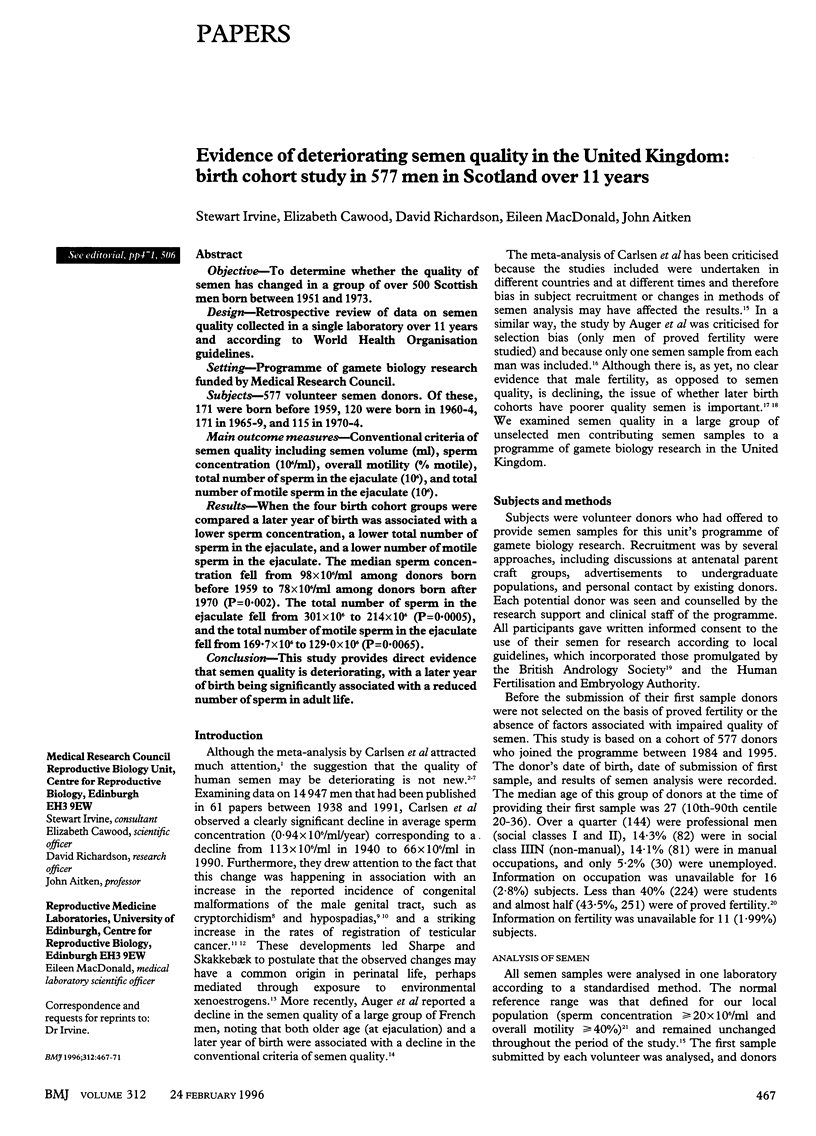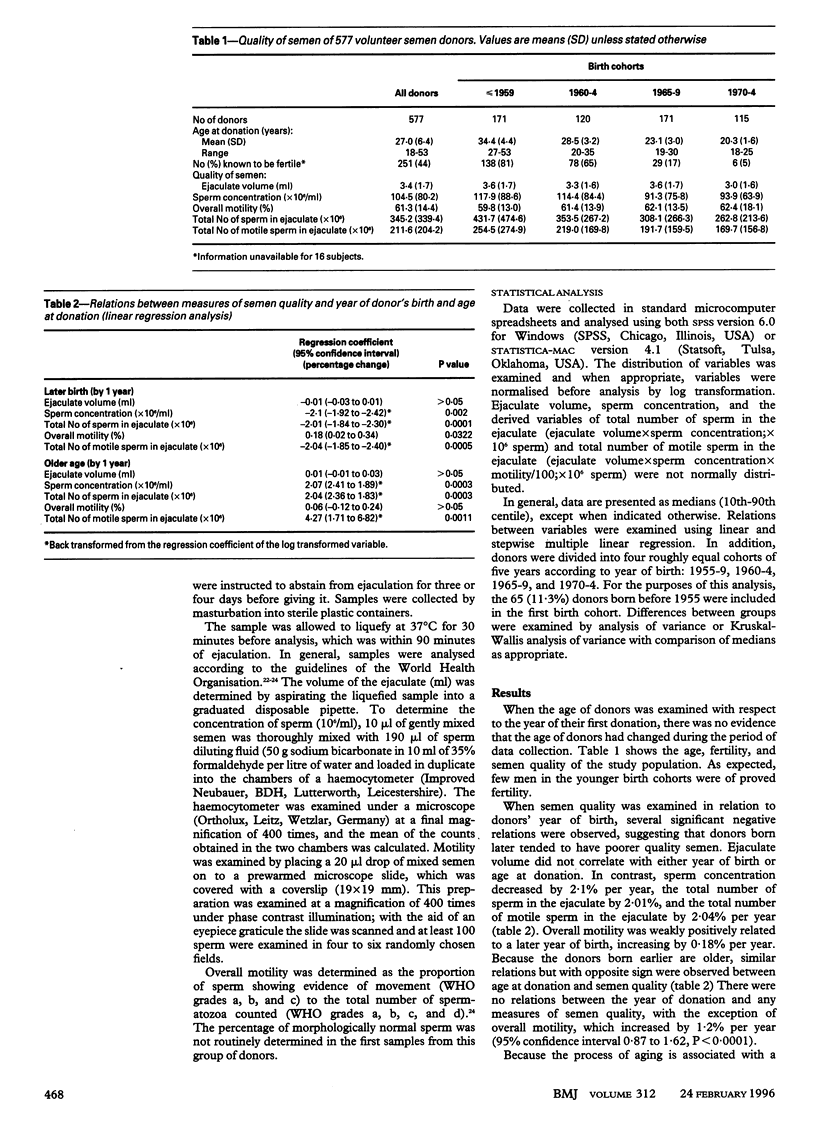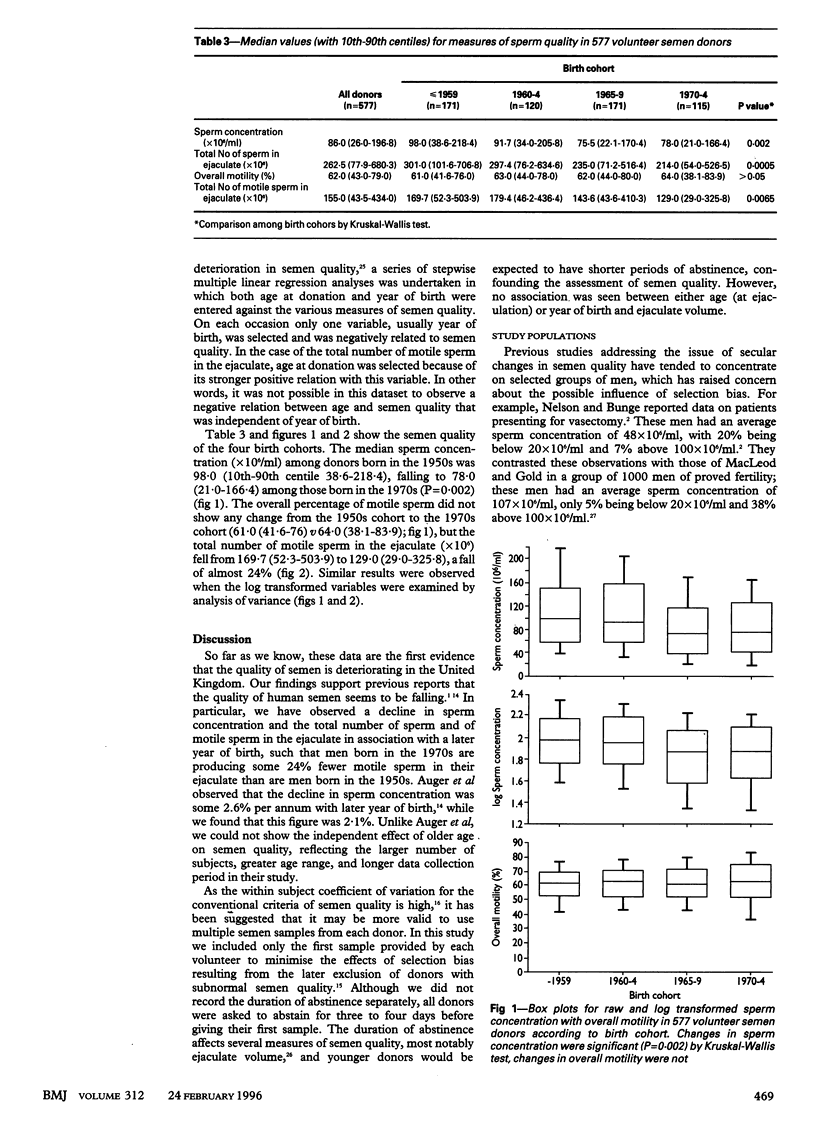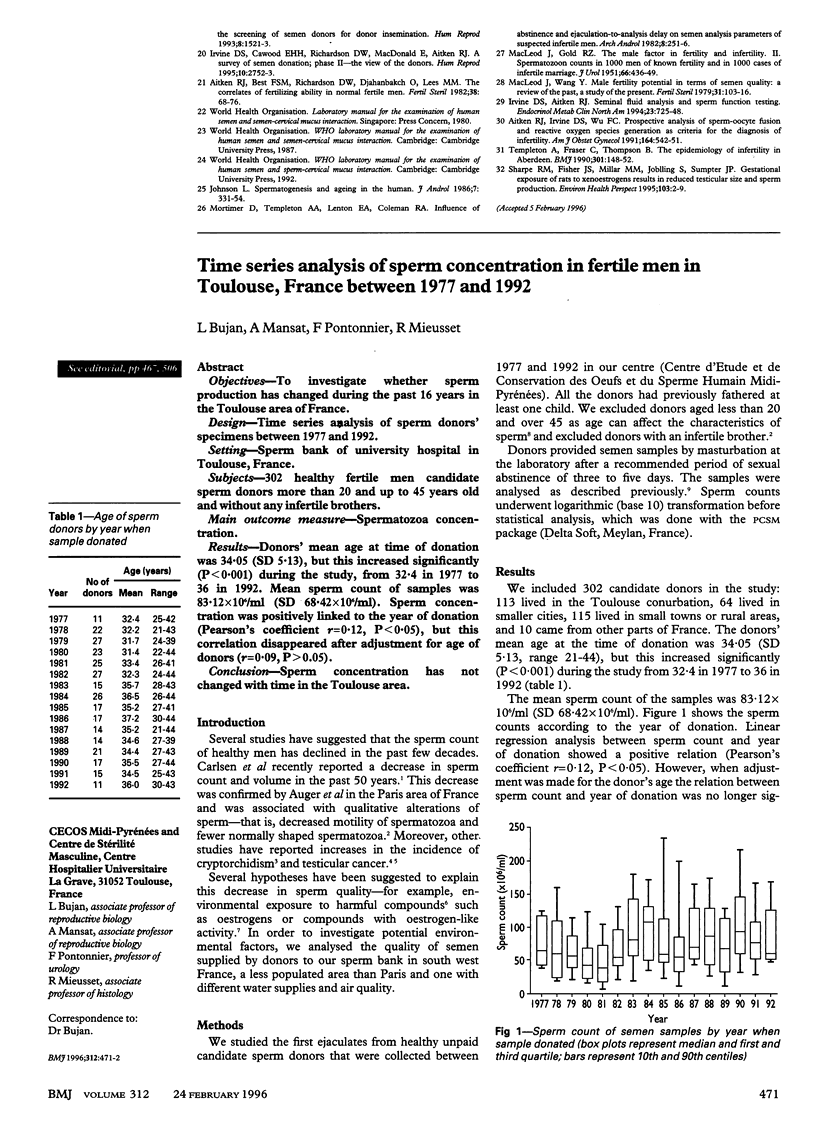Abstract
OBJECTIVE: To determine whether the quality of semen has changed in a group of over 500 Scottish men born between 1951 and 1973. DESIGN: Retrospective review of data on semen quality collected in a single laboratory over 11 years and according to World Health Organisation guidelines. SETTING: Programme of gamete biology research funded by Medical Research Council. SUBJECTS: 577 volunteer semen donors. Of these, 171 were born before 1959, 120 were born in 1960-4, 171 in 1965-9, and 115 in 1970-4. MAIN OUTCOME MEASURES: Conventional criteria of semen quality including semen volume (ml), sperm concentration (10(6)/ml), overall motility (% motile), total number of sperm in the ejaculate (10(6)), and total number of motile sperm in the ejaculate (10(6)). RESULTS: When the four birth cohort groups were compared a later year of birth was associated with a lower sperm concentration, a lower total number of sperm in the ejaculate, and a lower number of motile sperm in the ejaculate. The median sperm concentration fell from 98x10(6)/ml among donors born before 1959 to 78x10(6)/ml among donors born after 1970 (P=0.002). The total number of sperm in the ejaculate fell from 301x10(6) to 214x10(6) (P=0.0005), and the total number of motile sperm in the ejaculate fell from 169.7x10(6) to 129.0x10(6) (P=0.0065). CONCLUSION: This study provides direct evidence that semen quality is deteriorating, with a later year of birth being significantly associated with a reduced number of sperm in adult life.
Full text
PDF




Selected References
These references are in PubMed. This may not be the complete list of references from this article.
- Aitken R. J., Best F. S., Richardson D. W., Djahanbakhch O., Lees M. M. The correlates of fertilizing capacity in normal fertile men. Fertil Steril. 1982 Jul;38(1):68–76. doi: 10.1016/s0015-0282(16)46398-3. [DOI] [PubMed] [Google Scholar]
- Aitken R. J., Irvine D. S., Wu F. C. Prospective analysis of sperm-oocyte fusion and reactive oxygen species generation as criteria for the diagnosis of infertility. Am J Obstet Gynecol. 1991 Feb;164(2):542–551. doi: 10.1016/s0002-9378(11)80017-7. [DOI] [PubMed] [Google Scholar]
- Auger J., Kunstmann J. M., Czyglik F., Jouannet P. Decline in semen quality among fertile men in Paris during the past 20 years. N Engl J Med. 1995 Feb 2;332(5):281–285. doi: 10.1056/NEJM199502023320501. [DOI] [PubMed] [Google Scholar]
- Barratt C. L., Matson D. L., Holt W. British Andrology Society guidelines for the screening of semen donors for donor insemination. Hum Reprod. 1993 Sep;8(9):1521–1523. doi: 10.1093/oxfordjournals.humrep.a138291. [DOI] [PubMed] [Google Scholar]
- Boyle P., Kaye S. B., Robertson A. G. Changes in testicular cancer in Scotland. Eur J Cancer Clin Oncol. 1987 Jun;23(6):827–830. doi: 10.1016/0277-5379(87)90286-0. [DOI] [PubMed] [Google Scholar]
- Bromwich P., Cohen J., Stewart I., Walker A. Decline in sperm counts: an artefact of changed reference range of "normal"? BMJ. 1994 Jul 2;309(6946):19–22. doi: 10.1136/bmj.309.6946.19. [DOI] [PMC free article] [PubMed] [Google Scholar]
- Carlsen E., Giwercman A., Keiding N., Skakkebaek N. E. Evidence for decreasing quality of semen during past 50 years. BMJ. 1992 Sep 12;305(6854):609–613. doi: 10.1136/bmj.305.6854.609. [DOI] [PMC free article] [PubMed] [Google Scholar]
- Giwercman A., Skakkebaek N. E. The human testis--an organ at risk? Int J Androl. 1992 Oct;15(5):373–375. doi: 10.1111/j.1365-2605.1992.tb01351.x. [DOI] [PubMed] [Google Scholar]
- Irvine D. S., Aitken R. J. Seminal fluid analysis and sperm function testing. Endocrinol Metab Clin North Am. 1994 Dec;23(4):725–748. [PubMed] [Google Scholar]
- Irvine D. S., Cawood E. H., Richardson D. W., MacDonald E., Aitken R. J. A survey of semen donation: phase II the view of the donors. Hum Reprod. 1995 Oct;10(10):2752–2753. doi: 10.1093/oxfordjournals.humrep.a135786. [DOI] [PubMed] [Google Scholar]
- Jackson M. B. The epidemiology of cryptorchidism. John Radcliffe Hospital Cryptorchidism Research Group. Horm Res. 1988;30(4-5):153–156. doi: 10.1159/000181052. [DOI] [PubMed] [Google Scholar]
- James W. H. Secular trend in reported sperm counts. Andrologia. 1980 Jul-Aug;12(4):381–388. doi: 10.1111/j.1439-0272.1980.tb00650.x. [DOI] [PubMed] [Google Scholar]
- Johnson L. Spermatogenesis and aging in the human. J Androl. 1986 Nov-Dec;7(6):331–354. doi: 10.1002/j.1939-4640.1986.tb00943.x. [DOI] [PubMed] [Google Scholar]
- Leto S., Frensilli F. J. Changing parameters of donor semen. Fertil Steril. 1981 Dec;36(6):766–770. doi: 10.1016/s0015-0282(16)45923-6. [DOI] [PubMed] [Google Scholar]
- MACLEOD J., GOLD R. Z. The male factor in fertility and infertility. II. Spermatozoon counts in 1000 men of known fertility and in 1000 cases of infertile marriage. J Urol. 1951 Sep;66(3):436–449. doi: 10.1016/S0022-5347(17)74358-3. [DOI] [PubMed] [Google Scholar]
- MacLeod J., Wang Y. Male fertility potential in terms of semen quality: a review of the past, a study of the present. Fertil Steril. 1979 Feb;31(2):103–116. doi: 10.1016/s0015-0282(16)43808-2. [DOI] [PubMed] [Google Scholar]
- Menkveld R., Van Zyl J. A., Kotze T. J., Joubert G. Possible changes in male fertility over a 15-year period. Arch Androl. 1986;17(2):143–144. doi: 10.3109/01485018608990186. [DOI] [PubMed] [Google Scholar]
- Mortimer D., Templeton A. A., Lenton E. A., Coleman R. A. Influence of abstinence and ejaculation-to-analysis delay on semen analysis parameters of suspected infertile men. Arch Androl. 1982 Jun;8(4):251–256. doi: 10.3109/01485018208990205. [DOI] [PubMed] [Google Scholar]
- Nelson C. M., Bunge R. G. Semen analysis: evidence for changing parameters of male fertility potential. Fertil Steril. 1974 Jun;25(6):503–507. doi: 10.1016/s0015-0282(16)40454-1. [DOI] [PubMed] [Google Scholar]
- Osser S., Liedholm P., Ranstam J. Depressed semen quality: a study over two decades. Arch Androl. 1984;12(1):113–116. doi: 10.3109/01485018409161159. [DOI] [PubMed] [Google Scholar]
- Sharpe R. M., Skakkebaek N. E. Are oestrogens involved in falling sperm counts and disorders of the male reproductive tract? Lancet. 1993 May 29;341(8857):1392–1395. doi: 10.1016/0140-6736(93)90953-e. [DOI] [PubMed] [Google Scholar]
- Sherins R. J. Are semen quality and male fertility changing? N Engl J Med. 1995 Feb 2;332(5):327–328. doi: 10.1056/NEJM199502023320510. [DOI] [PubMed] [Google Scholar]
- Templeton A., Fraser C., Thompson B. The epidemiology of infertility in Aberdeen. BMJ. 1990 Jul 21;301(6744):148–152. doi: 10.1136/bmj.301.6744.148. [DOI] [PMC free article] [PubMed] [Google Scholar]


